by Mary Howard
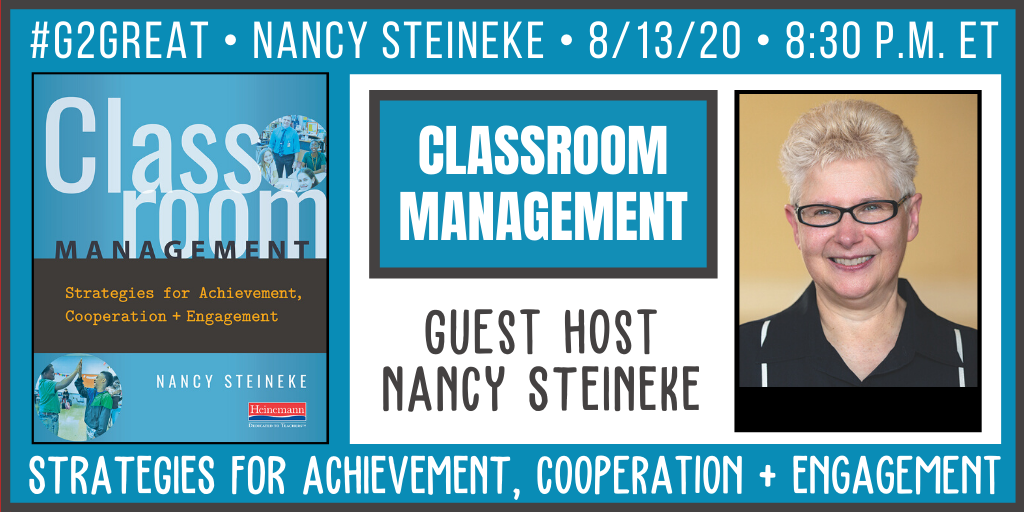
On 8/13/20, we welcomed first time #G2Great guest host Nancy Steineke to our chat to discuss her incredible new book: Classroom Management: Strategies for Achievement, Cooperation, and Engagement (Heinemann). We explored this topic on 2/6/20 in Weeding Misguided and Harmful Practices: Behavior Management and 10/16/16 in Classroom Management with Heart: Facilitating Intrinsic Motivation but it was a distinct honor to have Nancy share her wisdom as an author and educator who brought this topic to life.
I first heard about Classroom Management when Heinemann Publishing shared Nancy’s podcast: Building a Collaborative Classroom. Listening to her words, I was so mesmerized by the message that I immediately began to capture her thinking on my notes I could share. There was so much wisdom but it was these words that lingered with me long after the podcast ended:
“When teachers try to control their students, it makes you a sheriff in the town and everyone else then becomes a potential criminal. That’s not a way for a teacher to teach and it offers kids very little reason to buy into what the sheriff is proposing.”
This is a stark reality of how classroom management is too often perceived. This disconnect is evidenced by the continued fascination with suspect yet very popular management ploys such as Clip Up/Down Charts and varied tools that elicits the image of an instructional “sheriff” publicly labeling students according to a level of behavioral compliance. This is far removed from the collaborative process Nancy describes in her book and it sets us all up for failure and may have serious consequences for our students. Nancy clearly explains this mismatch on page 5 of Classroom Management:
Through a system of numerous sticks with possibly a few carrots (the most common carrot being “Behave and I, the teacher, will leave you alone”) might induce student compliance in the moment, it does damage in the long run. Our students might learn to be quiet and follow our directions without a question, but do these students’ behaviors prepare them to be independent learners beyond your classroom? Do they reflect deep content learning? No. They simply teach students how to survive in your classroom?
We asked Nancy to respond to three questions around her book that I’ll share across this post. As we dig deeper into classroom management, it seems as if contemplating her writerly BOOK WHY is a good starting point:
What motivated you to write this book? What impact did you hope it would have on the professional world?
Classroom management is challenging, often a burden we wrestle with silently because admitting management problems feels like admitting weakness. Compounding the problem, many of us entered our work without positive role models to emulate. When I was a student, my teachers relied on the twin weapons of compliance and punishment in their quest for class control. In moments of desperation early in my career, I fell back on those tools as well. Through trial and error I stumbled along, gradually refining my work with students until finally reaching this conclusion: For students and teachers to thrive, we have to develop and nurture positive relationships with students and between students.
But, fostering a supportive classroom community is easier said than done. Depending on grade level, teachers manage 30 to 175 co-workers (students) every day. Plus, we teachers have to cover our content as well! Because of the ever present pressures of limited time for content coverage combined with looming high stakes assessments, it’s easy for teachers to slip back into that rut of compliance and punishment because it seems expedient. Unfortunately, neither students nor teachers thrive under these conditions. Expecting unquestioning compliance often creates a “teacher versus students” atmosphere and the result is untold stress and dissatisfaction for everyone.
So what motivated me to write this book? My hope is that the lessons and insights offered will guide teachers to move towards a more collaborative approach to classroom management that enables teachers and students to work together. Also, this “roadmap” will give teachers direction and help them avoid the time wasting, relationship wasting “trial and error” classroom management learning curve so many of us struggle with.
I suspect that every educator reading her words can relate to how our own experiences can shape how we view and approach classroom management – for better or worse. I’d like to highlight words that are especially relevant at a time in our history where we find ourselves in the midst of a pandemic induced challenge the likes of which none of us have experienced before:
“For students and teachers to thrive, we have to develop and nurture positive relationships with students and between students.”
Nancy acknowledges that there are inherent challenges associated with this lofty goal. Luckily for all of us, she addresses that challenge across the pages of her book as well as within our #G2great chat. And so with her book in my mind, I carefully revisited her twitter inspired wisdom and noticed several important points that can support educators as they begin to maneuver this inevitable shifting view challenge. I’m so grateful for Nancy’s generous chat wisdom that formed the basis of these eight BIG IDEAS:
BIG IDEA #1: Maintain your sights on the ultimate goal
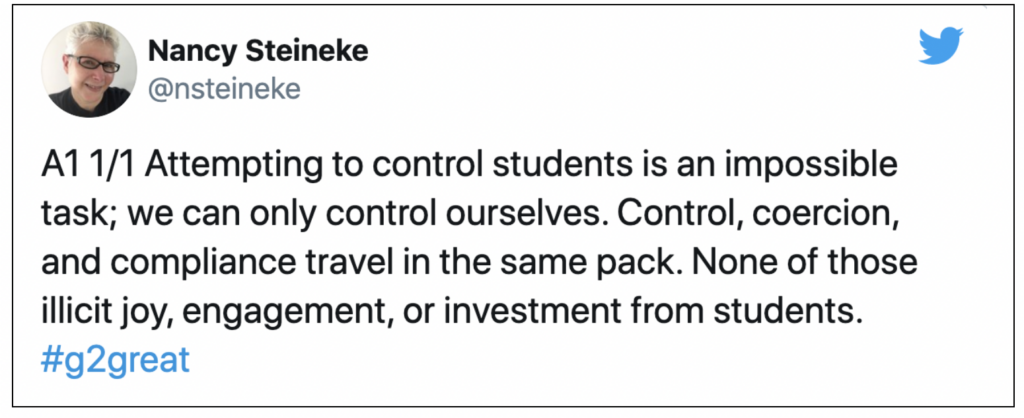
I open with this tweet since how we approach classroom management can serve as a roadblock or an invitation to “joy, engagement, and investment from students” that surfaces based our guiding purpose. As Nancy reminds us, the contradictory message that accompanies the triplet terms of control, coercion and compliance is likely to have a negative impact on students and can also blur how we interact with students in ways that could make that impact linger for the long haul.
BIG IDEA #2: Define the term “Classroom Management”
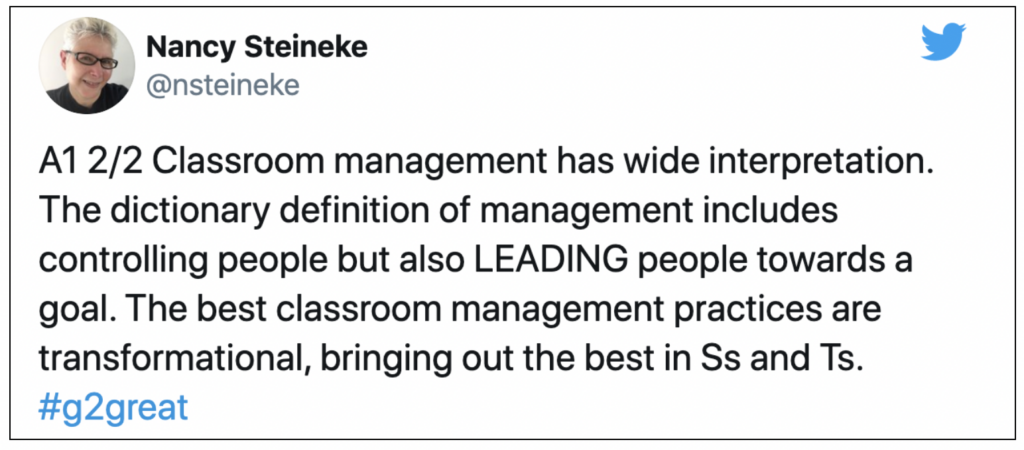
Early in the chat, Nancy distinguished between two opposing meanings of “classroom management.” This is an essential reminder that it’s not the term that is problematic but how we define and interpret that term in the company of children. The key word is “transformational” as it applies to the reach our definition in action can have on its recipients. Control is short lived but often has unwanted consequences. Transformational implies that this reach will change students in positive ways for the long-term.
BIG IDEA #3: Embrace community as your foundation
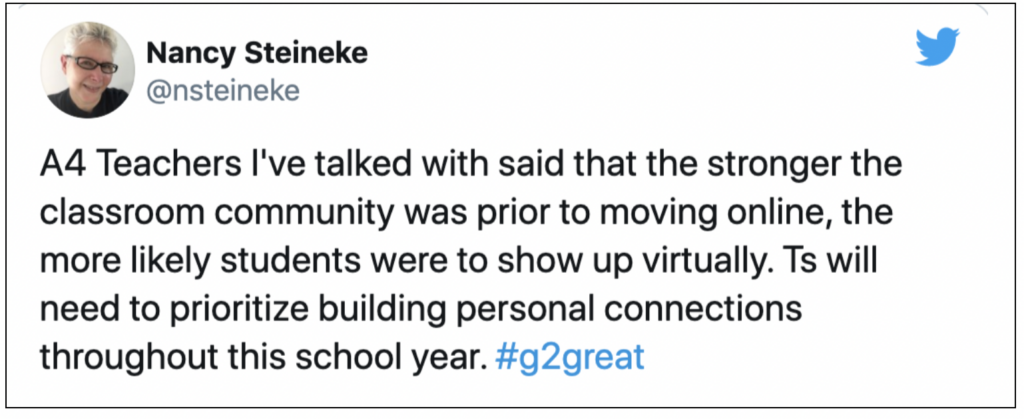
Nancy’s point about building community even in the best of times and what that could look like in the worst of times is important. As many schools are transitioning to the new year in a virtual space, we must cannot lose sight that those personal connections are more critical than ever. Relationships, community and connections put us on solid ground regardless of the topic, grade or setting. This should be our first consideration no matter where or what learning takes place.
BIG IDEA #4: Offer clear and explicit instruction
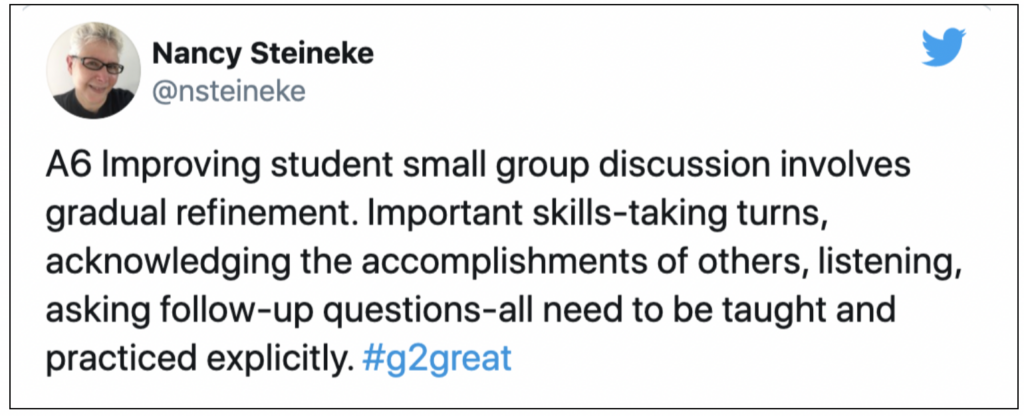
We must acknowledge that the positive classroom learning environment our children need to thrive will not happen by chance. This requires us to explicitly and consistently support these understandings through teacher modeling, teacher and peer supported practice and ongoing independent application. This is not something that can merely be scheduled into the calendar. Rather, it must become integral to what we do across the learning year to ensure student success over time.
BIG IDEA #5: Create visible paper trail references
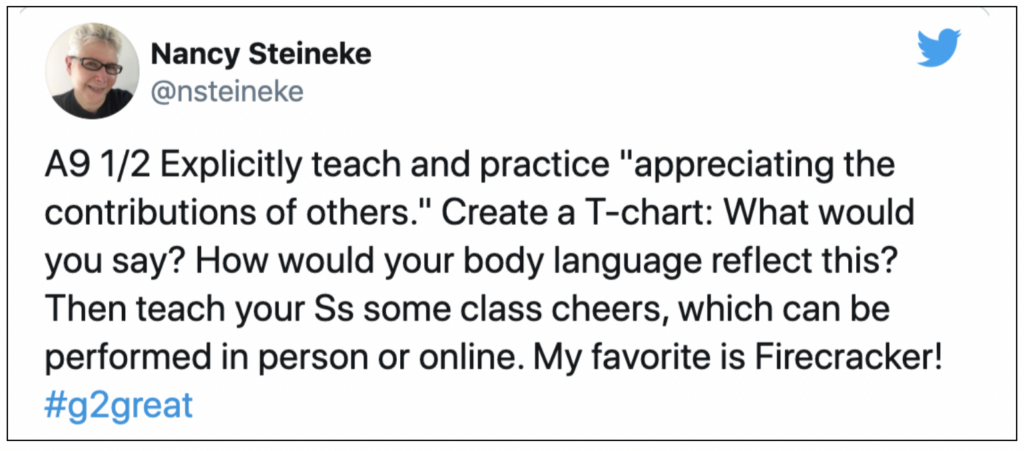
To support students as they move from explicit instruction and in-progress learning over time, it is helpful to create concrete visual paper trails. These can offer supportive tools that students can refer to and watch grow along with their growing understandings and shifting perspectives. When these tools are co-created, students take ownership of those written ideas as they engage in problem solving behaviors with peers that will then lead them to increasing collective independence.
BIG IDEA #6: Look beyond your own lens of understanding
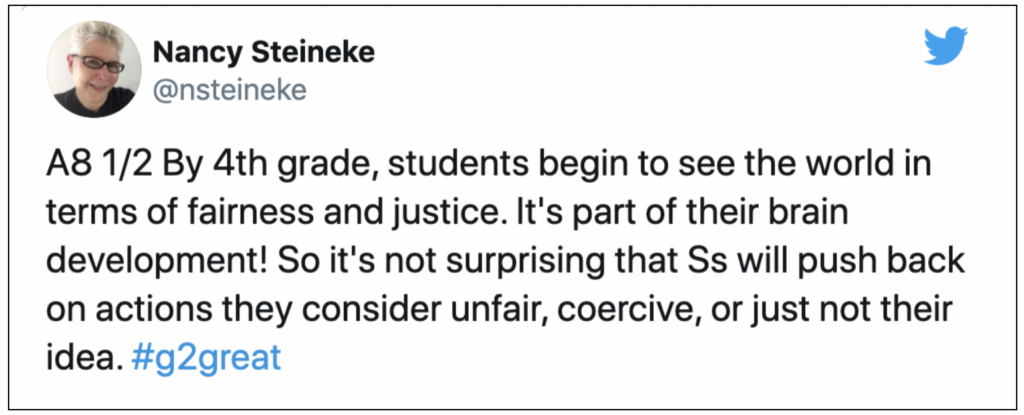
It’s human nature to approach our lives by gazing through a personal reflective mirror as a measure for everything around us. Unfortunately this can promote an “all about me” perspective. But when we are willing to turn that reflective lens based on the perspective of students, it will allow us to honor what we do from their viewpoint. In the process, we understand that their behaviors tell us a great deal about who they are and even suggest how we may be inadvertently contributing to those behaviors.
BIG IDEA #7: Celebrate your role as decision-maker

Nancy’s story illustrates the power of choice and how those choices can provoke or empower students. Our day–to-day observations inform those decisions. Thus if we recognize our choices are flawed we can open our minds to use those choices as a springboard to new thinking based on the needs of students. It takes courageous commitment to recognize a mismatch between what we do and the reality of how what we do impacts students. This can be a professional nudge to adjust our choices on their behalf.
BIG IDEA #8: Invite negotiation leading to meaningful shifts
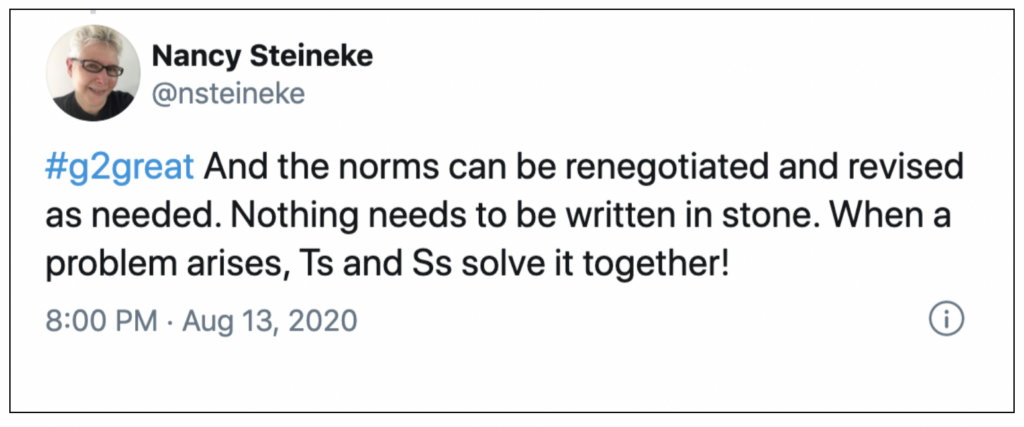
Nancy helps us to understand classroom management based on a spirit of collaboration between teachers and students. Collaborative negotiation invites student voices as we create a partnership in an ongoing process that celebrates shared ownership of the learning process. I see this as the heart and soul of the “classroom management” Nancy so eloquently describes in her book. Her words inspire us to redefine classroom management so that we might redesign what that could look like in action.
With these big ideas in mind, I’d like to turn back to Nancy’s words of wisdom in our next reflective question. Her hopeful takeaways support and extend the eight BIG IDEAS that Nancy inspired:
What are your big takeaways from your book that you hope teachers will embrace in their teaching practices?
- The most productive approach for managing a classroom is to do it with our students, collaborating with them to build a classroom community.
- Expanding responsibility to your students in a thoughtful and scaffolded way isn’t losing control: it is freeing to everyone.
- A teacher should never try to “go it alone.” When problems occur, it is an opportunity to collaborate and problem solve with the class.
- Strong relationships are based on mutual respect. True respect comes when teachers deliberately build a bridge between their own perspectives and the realities of their students.
My final thoughts…
As an extension to my BIG IDEAS and Nancy’s takeaways, I’d like to add two final tweets. In these additions, Nancy beautifully integrates our current reality as many educators face a new school year within a virtual space. This is wise advice as the 2020-2021 school year begins anew:


On behalf of our #G2great team, I would like to express deep gratitude to Nancy Steineke. The knowledge she so generously shares in her book and on our #G2great chat is relevant to us all no matter what or where we may teach. Her words renew my hope that educators everywhere can begin to re-envision how they will approach classroom management in the future. I find it comforting to know students will become the fortunate benefactors of this renewed spirit for a familiar term. This is Nancy’s gift to each of us.
And so I close this post with Nancy’s sage advice in our final question:
What is message from the heart you would like for every teacher to keep in mind?
When working with students, do your best to see their perspective and put yourself in their shoes. How would you feel if you received the feedback you’re tempted to share with a student? Would it make you feel happy and appreciated or resentful, hurt, sad, or angry? No one enjoys humiliation and it is natural for a student to make an effort to save face at the teacher’s expense, escalating a conflict. Instead of offering students negative feedback, be attentive to all the positive contributions students bring to your classroom every day. Celebrate each student by telling them what you’ve noticed, showing that each and every one of them is an appreciated, important member of your class.
Thank you, Nancy!
LINKS
Classroom Management: Strategies for Achievement, Cooperation, and Engagement by Nancy Steineke (Heinemann, 2020)
Heinemann Podcast with Nancy Steineke: Building a Collaborative Classroom
My notes on Nancy’s Podcast
Positive Notes from Nancy Steineke
Creating Safe Spaces in a Virtual Community How to Develop Online Classroom Norms from Nancy Steineke